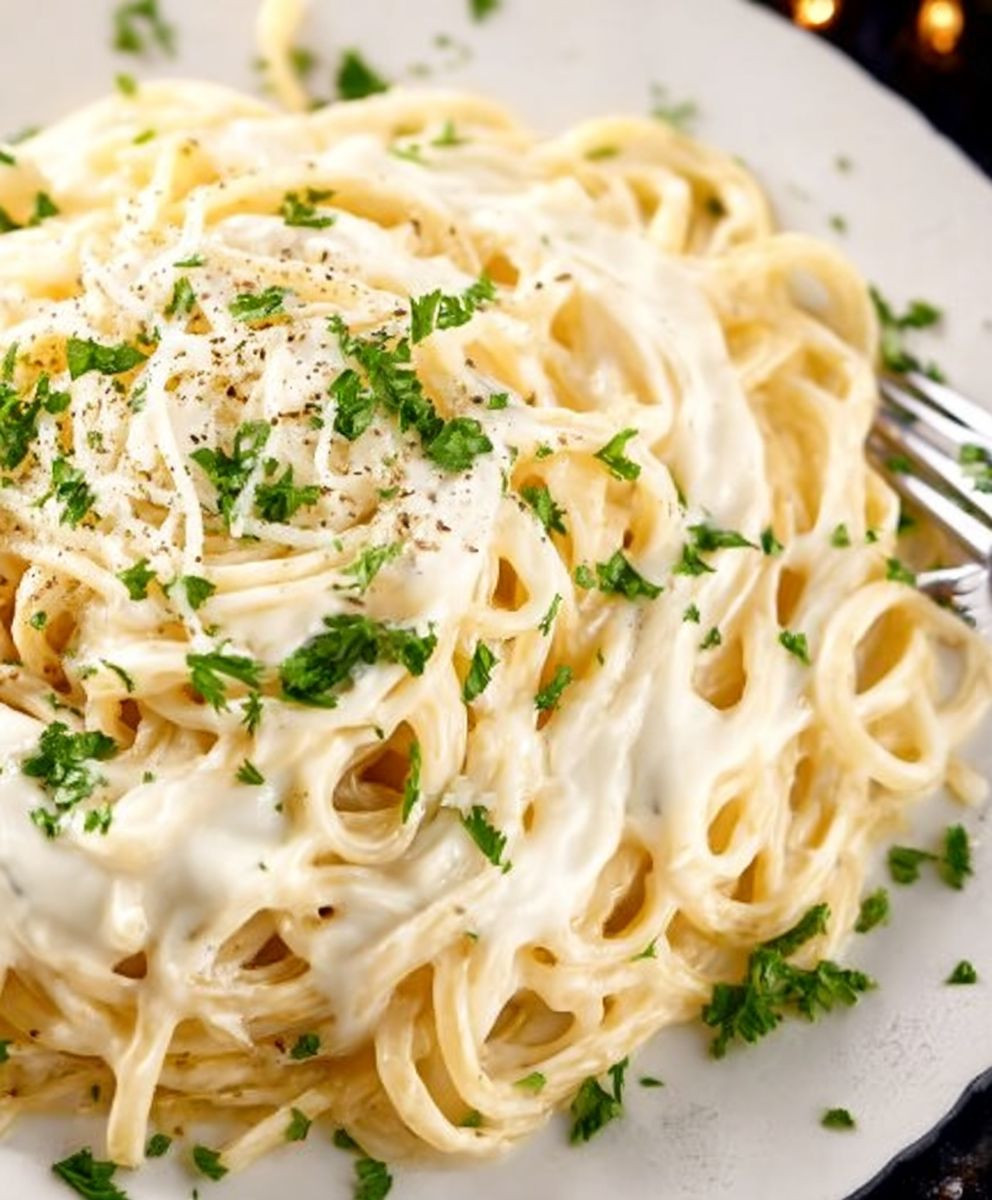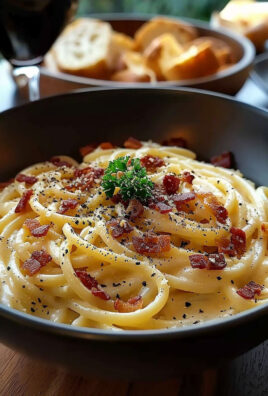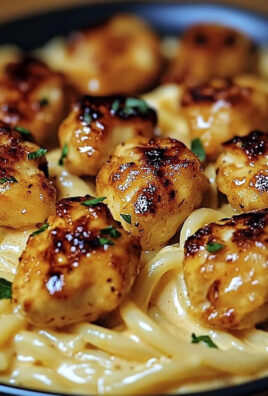Olive Garden Alfredo Sauce, that creamy, dreamy indulgence that makes pasta night feel like a special occasion, is now within your reach! Have you ever craved that rich, velvety sauce but didn’t want to brave the restaurant crowds? Or perhaps you’re looking to recreate that comforting flavor in the comfort of your own kitchen? Well, you’re in luck! This recipe brings the magic of Olive Garden’s Alfredo directly to your table.
While Alfredo sauce, in its simplest form, originated in Rome, Italy, the Americanized version, popularized by restaurants like Olive Garden, has taken on a life of its own. It’s become synonymous with comfort food and a decadent treat. What’s not to love? The combination of butter, cream, and Parmesan cheese creates a symphony of flavors that coats every strand of pasta in pure bliss. The texture is unbelievably smooth, and the aroma alone is enough to make your mouth water.
People adore Olive Garden Alfredo Sauce for its simplicity and satisfying taste. It’s quick to prepare, requiring minimal ingredients and effort, making it perfect for busy weeknights or impromptu gatherings. Plus, it’s incredibly versatile! You can toss it with your favorite pasta, add grilled chicken or shrimp, or even use it as a base for a creamy vegetable bake. Get ready to experience the joy of homemade Alfredo that rivals the restaurant version – you won’t be disappointed!
Ingredients:
- 1 cup (2 sticks) unsalted butter
- 1 pint heavy cream
- 1 ½ cups grated Parmesan cheese, plus more for serving
- ¼ teaspoon garlic powder
- ¼ teaspoon ground nutmeg
- Salt and freshly ground black pepper to taste
- 1 pound fettuccine pasta
- Optional: Chopped fresh parsley for garnish
Preparing the Alfredo Sauce:
- Melt the Butter: In a large, heavy-bottomed saucepan, melt the butter over medium-low heat. Be patient and let it melt slowly to prevent it from browning. We want a nice, smooth, and creamy base for our sauce.
- Add the Heavy Cream: Once the butter is completely melted, gradually pour in the heavy cream. Stir constantly with a whisk to combine the butter and cream. This is crucial to prevent the sauce from separating later on.
- Simmer Gently: Increase the heat slightly to medium, and bring the mixture to a gentle simmer. Don’t let it boil! Boiling can cause the cream to curdle. We want a slow, steady simmer that allows the flavors to meld together beautifully. Simmer for about 5-7 minutes, stirring occasionally, until the cream has slightly thickened.
- Incorporate the Parmesan Cheese: Reduce the heat to low. Now, it’s time for the star of the show – the Parmesan cheese! Add the grated Parmesan cheese, about ½ cup at a time, whisking constantly until each addition is fully melted and incorporated before adding the next. This gradual addition ensures a smooth and creamy sauce without any clumps. Make sure you’re using freshly grated Parmesan for the best flavor and texture. Pre-shredded cheese often contains cellulose, which can prevent it from melting properly.
- Season with Garlic Powder and Nutmeg: Add the garlic powder and ground nutmeg to the sauce. These seemingly small additions add a wonderful depth of flavor. The garlic powder provides a subtle savory note, while the nutmeg adds a hint of warmth and complexity. Stir well to distribute the spices evenly.
- Season to Taste: Season the Alfredo sauce with salt and freshly ground black pepper to taste. Remember that Parmesan cheese is already quite salty, so start with a small amount of salt and add more as needed. Taste the sauce frequently and adjust the seasoning until it’s just right for your palate.
- Keep Warm: Once the sauce is ready, keep it warm over very low heat while you cook the pasta. If the sauce becomes too thick, you can add a splash of pasta water to thin it out.
Cooking the Fettuccine Pasta:
- Bring Water to a Boil: Fill a large pot with plenty of water (at least 6 quarts). Add a generous pinch of salt to the water. The salt not only seasons the pasta but also helps to prevent it from sticking together. Bring the water to a rolling boil over high heat.
- Cook the Pasta: Once the water is boiling, add the fettuccine pasta. Stir immediately to prevent the pasta from sticking to the bottom of the pot. Cook the pasta according to the package directions, or until it is al dente. Al dente means “to the tooth” in Italian, and it refers to pasta that is cooked through but still firm to the bite. Overcooked pasta will be mushy and unappetizing.
- Reserve Pasta Water: Before draining the pasta, reserve about 1 cup of the pasta water. This starchy water is liquid gold! It can be used to thin out the Alfredo sauce and help it cling to the pasta.
- Drain the Pasta: Drain the pasta in a colander. Do not rinse the pasta unless you are using it for a cold pasta salad. Rinsing removes the starch, which helps the sauce adhere to the pasta.
Combining Pasta and Sauce:
- Add Pasta to Sauce: Immediately add the drained pasta to the saucepan with the warm Alfredo sauce. Toss gently but thoroughly to coat the pasta evenly with the sauce. Use tongs or two large forks to lift and toss the pasta, ensuring that every strand is covered in creamy goodness.
- Adjust Consistency: If the sauce is too thick, add a little of the reserved pasta water, a tablespoon at a time, until it reaches your desired consistency. The pasta water will not only thin out the sauce but also add a richness and silkiness that you won’t get from plain water.
- Serve Immediately: Serve the Alfredo pasta immediately while it’s hot and creamy. Garnish with extra grated Parmesan cheese and chopped fresh parsley, if desired. A sprinkle of red pepper flakes can also add a nice touch of heat.
Tips for the Best Alfredo Sauce:
- Use High-Quality Ingredients: The quality of your ingredients will directly impact the flavor of your Alfredo sauce. Use good-quality butter, heavy cream, and, most importantly, freshly grated Parmesan cheese.
- Don’t Overcook the Pasta: Al dente pasta is key to a great Alfredo dish. Overcooked pasta will be mushy and won’t hold the sauce well.
- Grate Your Own Parmesan Cheese: Pre-shredded Parmesan cheese often contains cellulose, which can prevent it from melting properly. Freshly grated Parmesan cheese will melt smoothly and create a creamier sauce.
- Don’t Boil the Cream: Boiling the cream can cause it to curdle. Simmer the cream gently over medium heat to prevent this from happening.
- Add the Parmesan Cheese Gradually: Adding the Parmesan cheese gradually, about ½ cup at a time, ensures that it melts smoothly and doesn’t clump.
- Adjust the Seasoning: Taste the sauce frequently and adjust the seasoning to your liking. Remember that Parmesan cheese is already quite salty, so start with a small amount of salt and add more as needed.
- Serve Immediately: Alfredo sauce is best served immediately. As it sits, it can thicken and become less creamy.
- Add Protein: For a more substantial meal, add grilled chicken, shrimp, or scallops to the Alfredo pasta.
- Add Vegetables: Sautéed broccoli, spinach, or mushrooms are delicious additions to Alfredo pasta.
- Spice it Up: Add a pinch of red pepper flakes to the Alfredo sauce for a touch of heat.
Variations:
- Chicken Alfredo: Add cooked, diced chicken to the Alfredo pasta.
- Shrimp Alfredo: Add cooked shrimp to the Alfredo pasta.
- Vegetable Alfredo: Add sautéed vegetables, such as broccoli, spinach, or mushrooms, to the Alfredo pasta.
- Spicy Alfredo: Add a pinch of red pepper flakes to the Alfredo sauce for a touch of heat.
- Garlic Alfredo: Add more garlic powder or minced garlic to the Alfredo sauce for a more intense garlic flavor.
- Lemon Alfredo: Add a squeeze of lemon juice to the Alfredo sauce for a bright and tangy flavor.
- Mushroom Alfredo: Sauté sliced mushrooms in butter until tender, then add them to the Alfredo sauce.
Troubleshooting:
- Sauce is too thick: Add a little reserved pasta water or milk to thin it out.
- Sauce is too thin: Simmer the sauce for a few more minutes to allow it to thicken.
- Sauce is grainy: This is usually caused by using pre-shredded Parmesan cheese. Try using freshly grated Parmesan cheese next time.
- Sauce is curdled: This can happen if the cream is boiled. Start over and simmer the cream gently over medium heat.
Storage:
- Refrigerate: Store leftover Alfredo pasta in an airtight container in the refrigerator for up to 3 days.
- Reheating: Reheat Alfredo pasta gently in a saucepan over low heat, adding a little milk or cream to thin it out if necessary. You can also reheat it in the microwave, but be careful not to overheat it, as this can cause the sauce to separate.
- Freezing: Freezing Alfredo pasta is not recommended, as the sauce can separate and become grainy when thawed.
Conclusion:
So, there you have it! This Olive Garden Alfredo Sauce recipe is more than just a copycat; it’s a passport to creamy, cheesy, garlicky goodness that you can whip up in your own kitchen, anytime you crave that comforting Italian-American classic. I truly believe this recipe is a must-try for anyone who loves rich, flavorful sauces and wants to impress their family and friends without spending hours slaving away in the kitchen. It’s quick, it’s easy, and the results are simply divine.
Why is this recipe a must-try? Because it delivers that authentic Olive Garden Alfredo experience without the need for a restaurant visit. It’s perfect for busy weeknights when you want a satisfying meal without the fuss. Plus, you have complete control over the ingredients, ensuring a fresh and delicious outcome every single time. Forget the jarred sauces – this homemade version is a game-changer!
But the fun doesn’t stop there! This versatile Olive Garden Alfredo Sauce is just begging to be customized. Serve it over your favorite pasta, like fettuccine, linguine, or even penne. For a heartier meal, toss it with grilled chicken or shrimp. Want to add some veggies? Broccoli, asparagus, or spinach would be fantastic additions. You could even use it as a decadent sauce for pizza or as a dip for crusty bread. The possibilities are truly endless!
Here are a few serving suggestions and variations to get your creative juices flowing:
* Classic Fettuccine Alfredo: The quintessential pairing! Simply toss the sauce with cooked fettuccine and garnish with freshly grated Parmesan cheese and a sprinkle of parsley.
* Chicken Alfredo: Grill or pan-fry some chicken breasts, slice them thinly, and add them to the Alfredo sauce. Serve over pasta or rice.
* Shrimp Alfredo: Sauté some shrimp with garlic and butter, then toss them with the Alfredo sauce and pasta. A squeeze of lemon juice adds a bright touch.
* Vegetarian Alfredo: Add steamed broccoli, asparagus, or spinach to the sauce for a healthy and delicious vegetarian meal.
* Spicy Alfredo: Add a pinch of red pepper flakes or a dash of hot sauce to the sauce for a little kick.
* Baked Alfredo: Toss cooked pasta with the Alfredo sauce and your favorite toppings (like chicken, vegetables, or cheese), then bake in a casserole dish until bubbly and golden brown.
I’m so excited for you to try this recipe! I know you’re going to love it as much as I do. It’s become a staple in my kitchen, and I’m confident it will become one in yours too.
So, what are you waiting for? Gather your ingredients, put on your apron, and get ready to create some culinary magic. And most importantly, don’t be afraid to experiment and make it your own!
Once you’ve tried this amazing Olive Garden Alfredo Sauce recipe, I would absolutely love to hear about your experience. Did you make any variations? What did you serve it with? What did your family and friends think? Share your photos and stories in the comments below! Your feedback is invaluable, and it helps me continue to create recipes that you’ll love. Happy cooking!
Olive Garden Alfredo Sauce: The Ultimate Guide to Making It at Home
Creamy, rich, and utterly delicious classic Fettuccine Alfredo! This simple recipe uses fresh ingredients for the best flavor.
Ingredients
Instructions
Recipe Notes
- Use high-quality ingredients for the best flavor.
- Freshly grated Parmesan cheese melts best.
- Don’t overcook the pasta. Al dente is key.
- Don’t boil the cream, simmer gently.
- Add Parmesan cheese gradually.
- Taste and adjust seasoning as needed.
- Serve immediately.
- For a more substantial meal, add grilled chicken, shrimp, or scallops.
- Sautéed broccoli, spinach, or mushrooms are delicious additions.
- Add a pinch of red pepper flakes for a touch of heat.






Leave a Comment